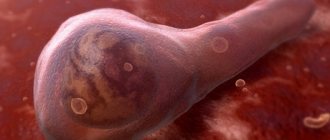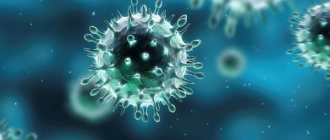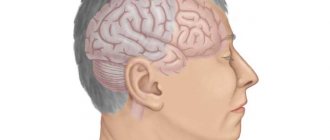Brief description of the disease
Leptospirosis has many names: infectious jaundice, water fever, Vasiliev-Weil disease, canine fever, Japanese day fever. All of them characterize an acute infectious disease, which is caused by parasitic microorganisms from the Leptospira family. The disease is characterized by symptoms of intoxication, multiple lesions of the liver and kidneys, and disturbances in the functioning of the nervous system. In severe cases, leptospirosis in humans leads to jaundice, meningitis, hemorrhagic syndrome and acute renal failure.
Etiology and pathogenesis
The causative agents of the infection belong to the parasitic species Interrogans of the Leptospiraceae family. They penetrate the host’s body through the skin and mucous membranes, and then settle in the lymph nodes and begin to actively multiply. Leptospirosis then spreads to other organs and systems, accumulating mainly in the kidneys, liver and central nervous system. The activity of harmful microorganisms leads to necrotic and degenerative changes in tissues, disruption of the integrity of the epithelium of the renal tubules, the development of disseminated intravascular coagulation syndrome and subsequent hemorrhagic rashes.
Epidemiology of the disease
The infection occurs on all continents, with the exception of Antarctica. Leptospirosis is especially widespread in countries with tropical humid climates. The carriers of the disease are wood mice, water rats, dogs, cattle, pigs, rats and some other animals. In people diagnosed with leptospirosis, symptoms appear after consuming meat and milk from infected animals, cutting meat, or prolonged contact with water contaminated with the excretions of carriers. The specificity of the pathogen entering the body determines the risk groups. The most frequently affected people are livestock farm workers, shepherds, milkmaids, veterinarians and people working in wet meadows. Typically, leptospirosis is diagnosed in people during the summer months, especially August, when conditions are ideal for the bacteria to multiply.
Leptospirosis in humans: symptoms, treatment
Leptospirosis in humans is a natural focal bacterial zoonotic pathology characterized by anemia, fever, hemorrhagic damage to the liver, kidneys, mucous membranes of the oral cavity, gastrointestinal tract, as well as disorders of the central nervous system. Leptospirosis is widespread on all continents except Antarctica, but it is most common in tropical countries.
The causative agent of leptospirosis is the aerobic gram-negative motile bacillus Leptospira interrogans; most of the microorganisms die quickly enough under the influence of high temperatures and sunlight. In dry soil, Leptospira can survive for about two hours, and in swampy soil - up to 10 months. The pathogens are able to tolerate freezing, so they easily survive the winter in frozen soil. Leptospira survives on food products for two days. In this case, these microorganisms die in a quarter of an hour under the influence of a half percent solution of phenol and one percent hydrochloric acid.
The main sources of infection are a variety of animals (rats, shrews, cattle, wood mice, water rats, pigs, voles, dogs and others). At the same time, a person with leptospirosis is not the source of the disease.
Human infection occurs when the skin and mucous membranes come into contact with moist soil contaminated with animal feces and water, when eating products containing feces of infected rodents, as well as through contact with the blood of infected animals during their slaughter or cutting of meat. In most cases, leptospirosis is of an occupational nature: workers in slaughterhouses, livestock farms, milkmaids, shepherds, veterinarians and people forced to work in wet fields are more susceptible to it.
The entry gate into the human body for Leptospira is the epithelium of the nasopharynx and digestive tract, sometimes the mucous membrane of the genital organs and urinary tract, as well as areas of damage to the skin. No pathological changes are observed in the area of pathogen penetration. Leptospires spread throughout the body with the lymph flow, settle in the lymph nodes, multiply there and disperse throughout the organs and systems using the circulatory system. Often the pathogen accumulates in the tissues of the liver, lungs, kidneys and spleen and causes local inflammation in them.
Symptoms of leptospirosis in humans
The latent period for leptospirosis lasts from four days to two weeks. The disease begins suddenly, acutely, without warning and is characterized by:
- chills;
- injection of scleral capillaries;
- increased temperature;
- severe headache;
- insomnia;
- constant thirst;
- severe pain in the calf and other muscles;
- myalgia accompanied by skin hyperesthesia;
- puffiness and hyperemia of the neck and face;
- loss of appetite.
On the fourth day after the first manifestation of signs of the disease, the symptoms are supplemented by icteric staining of the skin, the appearance of exanthema, hypotension, bradycardia, muffled heart sounds, as well as pathological changes in the epithelium of the respiratory tract. During the same period, in almost all patients the liver and spleen noticeably increase in volume, and symptoms of kidney tissue damage appear.
In severe cases of leptospirosis, toxicosis increases in patients, associated manifestations appear, and symptoms of uremia appear.
Treatment of leptospirosis in humans
A person infected with leptospirosis must be placed in a hospital if there is a high probability of complications occurring and developing in him, as well as in situations where doctors consider it appropriate to establish laboratory control over the general condition of his body over time.
Patients are prescribed strict bed rest until the fever disappears. In addition, when symptoms of kidney failure appear, patients also remain in bed. For functional disorders of the kidneys and liver, patients may be prescribed diet therapy.
Treatment of leptospirosis involves the use of antibiotics. In particular, patients are prescribed intramuscular benzylpenicillin, intravenous ampicillin, or doxycycline (for severe disease). In addition to all of the above, a specific anti-leptospirosis heterologous immunoglobulin is often included in the treatment complex.
Nonspecific therapy for leptospirosis includes the prescription of symptomatic medications, detoxification, and monitoring the general condition of the cardiovascular and respiratory systems.
In most cases, leptospirosis has a favorable prognosis. Deaths are mainly due to untimely or inadequate medical care and the general weakness of the infected person’s body.
Prevention of leptospirosis in humans
Prevention of leptospirosis includes the following measures:
- control over the level of disease in farm animals;
- vaccination (administration of a special leptospirosis vaccine to persons who constantly work in contact with animals, or to persons located in the epicenter of the epidemic during an outbreak of leptospirosis);
- constant control over the condition of water sources (including places where water resources are taken for the needs of the population, public places for swimming);
- limiting the reproduction of rats, mice and other rodents (deratization of agricultural farms, urban facilities).
Leptospirosis - symptoms of the disease
The incubation period of infection lasts from 2 weeks to 1 month. The disease begins with acute symptoms:
- severe chills;
- a sharp increase in body temperature to 39-40 degrees;
- headache;
- pronounced muscle pain (the calf muscles hurt very much);
- changes in the skin of the face - it becomes hyperemic, puffy. Patients experience dilation of blood vessels and conjunctival hyperemia, which often lead to hemorrhages.
In the first week after the onset of the disease, exanthems of various types may appear. In severe forms of the disease, hemorrhagic rashes are observed, localized on the elbows and in the armpits. In addition, when leptospirosis is diagnosed, treatment includes correction of the liver, kidneys and cardiovascular system, since patients develop urinary retention, Pasternatsky's symptom, rapid breathing, decreased blood pressure and tachycardia.
Signs of fever are observed for about a week, after which the temperature returns to normal. After 3-4 days, a new increase in temperature is possible, but this time it subsides after 1-2 days. In some cases, lectospirosis in humans leads to the development of icterus, which is accompanied by a significant enlargement of the liver and a change in the color of urine.
If left untreated, the disease causes serious complications - acute liver or kidney failure, meningitis, iritis, iridocyclitis and encephalitis. Depending on the state of a person’s immune system, other serious consequences may occur.
Treatment of leptospirosis during pregnancy
Leptospirosis is an extremely unfavorable disease during pregnancy. Even if the infection occurred during pregnancy, leptospirosis usually becomes an indication for abortion, even during the recovery stage. In this regard, it is recommended to protect yourself as much as possible from the risk of infection, and prevention of leptospirosis involves the following:
- deratization measures,
- protection of water supplies and food products from contamination by rodent secretions,
- prohibition of drinking water from open reservoirs,
- use of protective clothing when working in adverse conditions, caring for sick animals,
- carrying out veterinary, sanitary and reclamation works.
According to epidemic indications, adults and children over 8 years of age are vaccinated with killed polyvalent leptospirosis vaccine subcutaneously 2 times with an interval of 7-10 days, revaccination after 1 year, but the effectiveness of vaccine prevention has not been proven.
In an epidemic outbreak the following is carried out:
- final disinfection (as for intestinal infections), deratization;
- laboratory examination of patients with fever and those who have recovered from the disease within the last month;
- Animal products are subject to heat treatment, water is boiled.
Sanitary education work is aimed at familiarizing the population with the conditions of infection with leptospirosis, the clinical manifestations of the disease, and the need to quickly seek medical help. The dangers of swimming in stagnant bodies of water and the use of water from open bodies of water for drinking and household needs should be emphasized.
Leptospirosis - treatment of the disease
All patients are subject to mandatory hospitalization. Etiotropic therapy consists of taking penicillin. The standard dosage of the drug is 60,000 units/day. The main treatment for leptospirosis is doxycycline. Doctors also use gammaglobulin. Since there is a danger of developing renal pathologies, osmo- and saluretics are recommended for patients. Hemodialysis is prescribed when symptoms of acute renal failure occur.
For prevention purposes, it is necessary to regularly vaccinate personnel of livestock farms and enterprises involved in processing meat and dairy products.
Video from YouTube on the topic of the article:
Treatment of leptospirosis at home
Treatment of leptospirosis at home is not implemented, otherwise the prognosis cannot be favorable. Hospitalization is carried out in the infectious diseases or intensive care unit. In general, bed rest and nutrition are prescribed, taking into account the degree of damage to the kidneys and liver. Medicines are prescribed exclusively by professional doctors based on the diagnosis, as well as in order to eliminate the functional disorders associated with leptospirosis.










